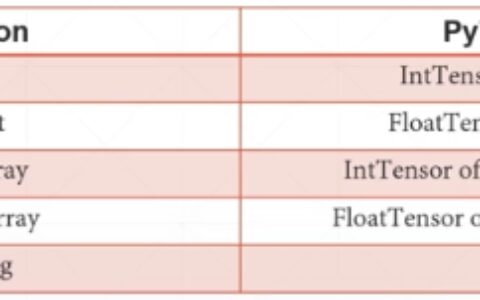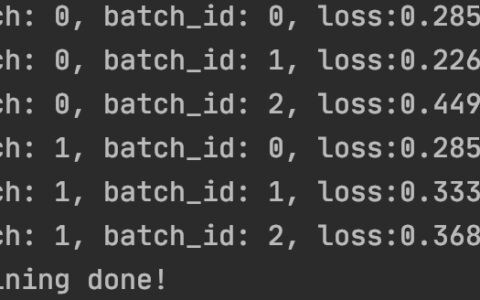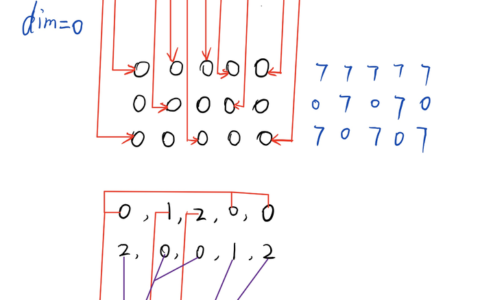分享PyTorch获取中间层输出的3种方法
在PyTorch中,我们可以使用多种方法来获取神经网络模型中间层的输出。本文将介绍三种常用的方法,并提供示例说明。
1. 使用register_forward_hook()方法
register_forward_hook()方法是一种常用的方法,用于在神经网络模型的前向传递过程中获取中间层的输出。以下是一个示例,展示如何使用register_forward_hook()方法获取中间层的输出。
import torch
import torch.nn as nn
class Net(nn.Module):
def __init__(self):
super(Net, self).__init__()
self.conv1 = nn.Conv2d(3, 16, 3, padding=1)
self.conv2 = nn.Conv2d(16, 32, 3, padding=1)
self.conv3 = nn.Conv2d(32, 64, 3, padding=1)
def forward(self, x):
x = torch.relu(self.conv1(x))
x = torch.relu(self.conv2(x))
x = torch.relu(self.conv3(x))
return x
model = Net()
# 定义一个列表,用于存储中间层的输出
outputs = []
# 定义一个钩子函数,用于获取中间层的输出
def hook(module, input, output):
outputs.append(output)
# 注册钩子函数
handle = model.conv2.register_forward_hook(hook)
# 运行模型
x = torch.randn(1, 3, 32, 32)
y = model(x)
# 打印中间层的输出
print(outputs[0].shape)
# 移除钩子函数
handle.remove()
在上面的示例中,我们首先创建了一个名为Net的简单神经网络模型,该模型包含三个卷积层。然后,我们定义了一个列表outputs,用于存储中间层的输出。接下来,我们定义了一个钩子函数hook,用于获取中间层的输出,并使用register_forward_hook()方法将钩子函数注册到第二个卷积层上。最后,我们运行模型,并打印中间层的输出。
2. 使用torch.jit.trace()方法
torch.jit.trace()方法是一种将PyTorch模型转换为Torch脚本的方法。在转换过程中,我们可以使用torch.jit.trace()方法获取中间层的输出。以下是一个示例,展示如何使用torch.jit.trace()方法获取中间层的输出。
import torch
import torch.nn as nn
class Net(nn.Module):
def __init__(self):
super(Net, self).__init__()
self.conv1 = nn.Conv2d(3, 16, 3, padding=1)
self.conv2 = nn.Conv2d(16, 32, 3, padding=1)
self.conv3 = nn.Conv2d(32, 64, 3, padding=1)
def forward(self, x):
x = torch.relu(self.conv1(x))
x = torch.relu(self.conv2(x))
x = torch.relu(self.conv3(x))
return x
model = Net()
# 将模型转换为Torch脚本
traced_model = torch.jit.trace(model, torch.randn(1, 3, 32, 32))
# 运行模型
x = torch.randn(1, 3, 32, 32)
y = traced_model(x)
# 打印中间层的输出
print(y[1].shape)
在上面的示例中,我们首先创建了一个名为Net的简单神经网络模型,该模型包含三个卷积层。然后,我们使用torch.jit.trace()方法将模型转换为Torch脚本,并使用torch.randn()方法生成一个随机输入张量。接下来,我们运行模型,并打印中间层的输出。
3. 使用torch.autograd.grad()方法
torch.autograd.grad()方法是一种用于计算梯度的方法,我们可以使用该方法获取中间层的输出。以下是一个示例,展示如何使用torch.autograd.grad()方法获取中间层的输出。
import torch
import torch.nn as nn
class Net(nn.Module):
def __init__(self):
super(Net, self).__init__()
self.conv1 = nn.Conv2d(3, 16, 3, padding=1)
self.conv2 = nn.Conv2d(16, 32, 3, padding=1)
self.conv3 = nn.Conv2d(32, 64, 3, padding=1)
def forward(self, x):
x = torch.relu(self.conv1(x))
x = torch.relu(self.conv2(x))
x = torch.relu(self.conv3(x))
return x
model = Net()
# 运行模型
x = torch.randn(1, 3, 32, 32)
y = model(x)
# 计算中间层的梯度
grads = torch.autograd.grad(y.mean(), model.conv2.parameters(), retain_graph=True)
# 打印中间层的输出
print(grads[0].shape)
在上面的示例中,我们首先创建了一个名为Net的简单神经网络模型,该模型包含三个卷积层。然后,我们使用torch.randn()方法生成一个随机输入张量,并运行模型。接下来,我们使用torch.autograd.grad()方法计算中间层的梯度,并打印中间层的输出。
本站文章如无特殊说明,均为本站原创,如若转载,请注明出处:分享Pytorch获取中间层输出的3种方法 - Python技术站

 微信扫一扫
微信扫一扫  支付宝扫一扫
支付宝扫一扫 




